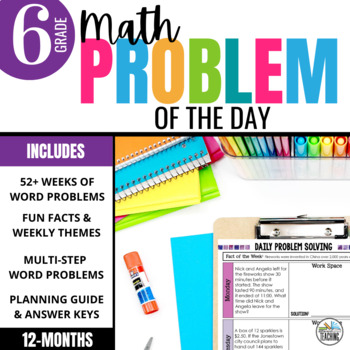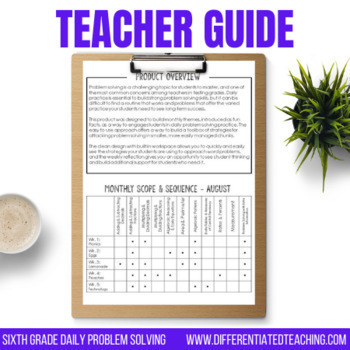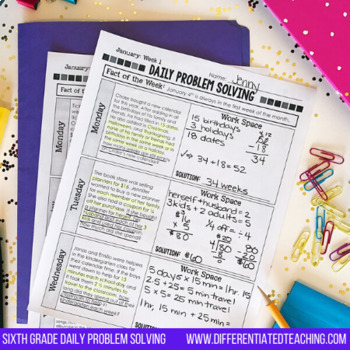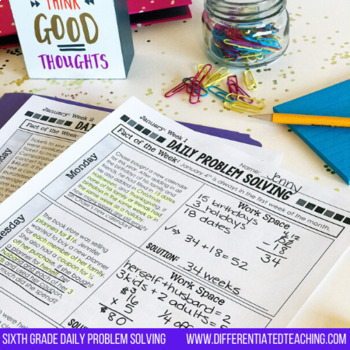6th Grade Math Word Problem of the Day | Full Year of Daily Math Problem Solving
- Zip
What educators are saying
Products in this Bundle (11)
showing 1-5 of 11 products
Bonus
Description
Problem solving is one of the most challenging skills we teach in math. Research shows the best way to build these skills is through short, purposeful daily practice with both single- and multi-step word problems. These themed math story problems are provided in a paper-saving print format.
Designed to take less than 15 minutes per day - including giving students time to solve, discuss, and review - each month's problems include single-step, multi-step, and word problems with extra information. This helps build students' capacity for critical thinking and mathematical problem-solving skills.
The problems increase in complexity across the months. This is purposefully done to help prepare your sixth-grade students for the types of problems they may see on state tests and as they progress through middle & high school math classes.
You'll receive:
• Daily Problem Solving Teacher's Guide
• 59 total weeks of themed word problems (nearly 300 word problems!)
• Answer keys
Word Problem Themes:
Each week includes a fun fact and the word problems are themed to align with monthly holidays, special events, and student-friendly topics. Here are the monthly themes:
✔January: Resolutions, Health & Body, MLK, Soup, and Winter Sports
✔ February: Groundhogs, Valentines, Breakfast, and February Fun
✔ March: Reading, Pi Day, St. Patrick's Day, Spring, and Space
✔ April: Friendship, Frogs, Library Week, Earth Day, and Baseball
✔ May: Video Games, Mother's Day, Bicycles, Summer Safety, and Barbecue
✔ June: Vacation, Flags, Father's Day, Water Sports, and Beaches
✔ July: Fireworks, Ice Cream, Amusement Parks, and Fish
✔ August: Picnics, Eggs, Lemonade, Peaches, and Technology
✔ September: Labor Day, Grandparents, Potatoes, Pirates, and Apples
✔ October: Pizza, Autumn, Pumpkins, Cookies, and Halloween
✔ November: Board Grames, Veterans, Turkeys, Thanksgiving, Football
✔ December: Animals, Sickness, Winter, Holidays, & Snow and Ice
Ways to Use the Problems:
• Daily warm-ups or math center
• Whole or small group math instruction
• Independent enrichment or challenge problems for early finishers
• Test prep
• Homework
Benefits of a Problem of the Day format:
❑ Daily practice builds routine and structure for practice
❑ Less overwhelming to reluctant or struggling learners
❑ Helps identify students who may need additional support
❑ Encourages discussion about skills & strategies
Need the digital version?
Get it here: 6th Grade Daily Problem Solving Print + Digital Bundle
This product is also available for other grade levels:
2nd grade 3rd Grade 4th grade 5th grade
Terms of Use:
© 2016 Rebecca Davies. All rights reserved by the author. These materials are intended for personal use by a single classroom only. Copying for more than one teacher, classroom, department, school, or school system is prohibited. For use in multiple classrooms, please purchase additional licenses. This product may not be distributed or displayed digitally for public view. Failure to comply is a copyright infringement and a violation of the Digital Millennium Copyright Act (DMCA). Clipart and elements found in this PDF are copyrighted and cannot be extracted and used outside of this file without permission or license. See product file for clip art and font credits.
Questions?
Click here to contact me directly via email.





